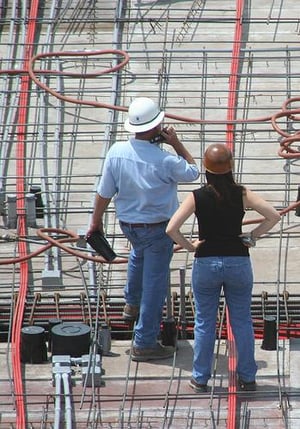Olympics Success to Inform Health & Safety Across Construction Sites
The Health and Safety successes of the construction projects involved in Britain's preparation for the London 2012 Olympics are being studied in order to find out how best to replicate them in construction projects across the country.
The Institution of Occupational Safety and Health (IOSH) and the Health and Safety Executive (HSE) have worked with Loughborough University to look at 5 aspects of the Olympics construction work which could be expanded into wider guidelines for all building site operations.
The first point identified by the study was that the Olympics constructions projects were “led from the top”. The ODA were very clear in the standards they expected and they did not lead in a 'hands-off' fashion. Instead, they communicated with workers at all levels and engaged with them about health and safety matters.
P oint two was that the Olympic project had competent supervisors. Supervisors were recruited and trained to have a good knowledge of health and safety issues, as well as the skills to communicate what was necessary to their staff in a way that positively influenced their behaviour and increased workers' understanding of why health and safety issues were important.
oint two was that the Olympic project had competent supervisors. Supervisors were recruited and trained to have a good knowledge of health and safety issues, as well as the skills to communicate what was necessary to their staff in a way that positively influenced their behaviour and increased workers' understanding of why health and safety issues were important.
The third factor which was identified to have contributed to an exceptionally good safety record was that the Olympic construction projects “foster[ed] an open, positive safety culture”. All of the workers on the 2012 construction sites were made aware that their supervisors and managers had prioritised their safety and wellbeing, which in turn made them “more likely” to be proactive themselves in promoting a positive safety culture.
The fourth point which the study identified as a key feature in having kept workers safe during the 2012 construction work was that good behaviour was rewarded and incentivised. Acts which promoted or encouraged good health and safety practices were rewarded, often by positive feedback, and this morale boost fostered further safe behaviour.
The final factor suggested by the study was that there was a culture of reviewing practices and learning from any problems or difficulties. The key to this being so successful was that the lessons which were learned were efficiently communicated throughout the organisation so that mistakes were not repeated.
What is particularly interesting is that these factors identified by IOSH, the ODA and Loughborough University are easy to apply to any construction business, regardless of its size. The safety success was not a matter of the vastness of the project being undertaken, or any special resources which they had available to them. Instead, the elements of behaviour and culture which led to the Health and Safety successes are transferable to even the smallest of construction firms.
IOSH executive director of policy Dr Luise Vassie said: “The ODA’s exemplary health and safety record speaks for itself. The techniques used were often low cost and had cross-company impact, showing that a good health and safety record isn’t out of any company’s grasp”.
There is also evidence that the good practices established during the construction work is already being carried into other construction sites by the workers. Stephen Williams, HSE director of operational strategy and London 2012 Games, said, “Evidence that change in workers’ safety behaviour has been sustained since they left the Olympic Park is a very encouraging sign that transfer of the good practice to other construction projects is already happening”.
Any improvement to safety on construction sites will be welcome across the country and this study shows that even relatively small changes can have exceedingly positive results.
(Image Credit: Ben Ostrowsky)
About Lisa Robinson
Lisa - word smith to the gods.
